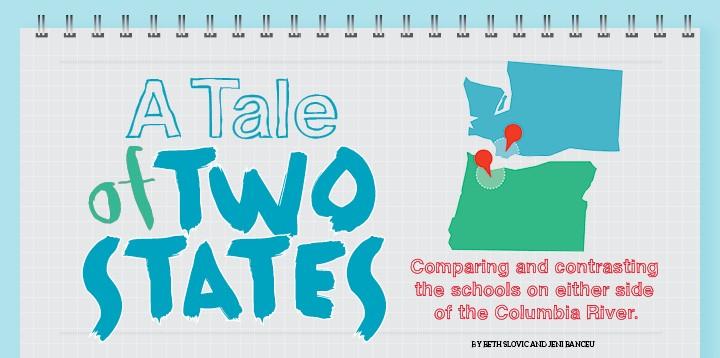
Not too long ago, Jackie and George Sacks found themselves in what many Portland parents would consider an enviable position.
Their quaint Northeast Portland bungalow sat squarely within the boundaries of one of Portland Public Schools’ most coveted K-8 schools, Beverly Cleary, which has consistently been considered as one of the best elementary schools in the city, based on state rankings.
But as the couple’s first child approached kindergarten in 2013, uncertainty crept in. Oregon’s largest district wanted to overhaul its elementary schools, shifting boundaries to spread enrollment more evenly through the district, to equalize class sizes and to address long-standing concerns about unequal opportunities at historically underserved schools.
Sacks attended a kindergarten open house in the well-heeled Grant Park neighborhood and found school administrators’ answers to her questions about art and music programming underwhelming, she said. This, despite the fact that the city had recently started collecting an arts tax to supplement school programming.
“I was quite frankly mortified,” said Sacks. “There was no clear plan. There was a lot of vague response.”
So Sacks and her family packed their bags and headed north, to Vancouver, Wash., where Sacks already worked as a high-school dance teacher. The move wasn’t without its sacrifices — Sacks’ husband still commutes to Hillsboro — and she acknowledges her family was privileged to be able to move.
But they were in search of one thing: predictability. “I don’t want to gamble,” said Sacks. “I believe in consistency. I believe in thoughtful design.”
For the Sacks family, the Evergreen School District in east Vancouver offered a solution to the question most families confront at least once in their parenting career: “Where should I send my child to school?”
For families who live in the Portland metro area, the question sometimes has an added component: Would Washington or Oregon better serve my child?
TWO STATES: TWO APPROACHES TO FUNDING
For years, Oregon outspent Washington on a per student basis, said John Tapogna, president of ECONorthwest, a Portland economic consulting firm. But recently, Washington — which relies on property taxes and sales taxes to fund its schools — has pulled ahead of Oregon, which uses funding from income and property taxes, plus lottery revenue, for schools.
But a key court ruling is likely to accelerate spending increases in Washington, said Tapogna. In June, lawmakers finally settled a lengthy court battle in which schools advocates alleged that Washington had failed to meet its constitutional obligation to adequately fund schools.
As a consequence, the Washington legislature infused an additional $1.6 billion into the state school fund for 2018-19. That’s expected to translate to higher salaries for teachers.
Washington already outperforms Oregon by a few key measures, including high school graduation rates and elementary math proficiency; the increased spending might serve to widen the lead.
OREGON’S DILEMMA
Oregon, meanwhile, faces a financial pitfall due in part to school districts’ growing obligation to fund the state’s pension system for all public employees. In 2017-18, on top of a teacher’s salary, districts had to pay an additional 24 percent to the state pension fund known as PERS. By 2021, districts will have to pay 31 percent, meaning they would send more than $15,000 to the state on top of every $50,000 in salary they spend. The state also has a cap on property taxes, no sales tax and low corporate taxes, reducing potential funding for schools and other services.
If Oregon fails to devise a financial fix and the economy slows, school districts may have to look at reducing staff or lopping off school days from the calendar. For now, district leaders hope a healthy economy buoys schools by offsetting the increased cost.
“Without some significant revenue reform and/or PERS reform, it will be a challenge not only for Beaverton but for other districts as well,” said Don Grotting, superintendent of the Beaverton School District. “We’re hoping there will be enough of an [economic] offset that we don’t have to reduce programs.”
Oregon’s Quality Education Commission regularly calculates how much it would cost to fund a highly effective school system in Oregon. For the current biennium, that number is almost $2 billion more than the $8.2 billion the state is already dedicating to education.
Plenty of parents, of course, continue to choose Oregon schools. In the Portland area, more diverse communities and an expanding system of language-immersion programs draw parents to local schools.
ONE FAMILY’S BI-STATE SOLUTION
Some local families take advantage of both state’s offerings.
Jeff Crockett and his wife, Jenna Biggs, both teach in Vancouver; he’s in the Evergreen district and she’s in Vancouver Public Schools, to the west of Evergreen. But they live in Portland and keep their daughter in a Portland Public Schools’ Spanish-immersion program.
“I’m really happy about the Spanish immersion,” said Crockett. “The language, it’s just an incredible thing to see her acquiring.”
He sees the differences between Washington and Oregon nearly every day, though; In 2017-18 he taught third grade north of the Columbia River, and his daughter, Willa, attended third grade at Sitton Elementary School in the St. Johns neighborhood of North Portland.
His school, Crestline Elementary, burned to the ground in 2013 after a teen started a fire when the building was unoccupied. Evergreen rebuilt the campus in 2014, and today it stands out as a sparkling, state-of-the art school with meticulously landscaped grounds, security cameras and new playground equipment.
Apartment buildings dot the immediate neighborhood around Crestline, just as they do near Sitton.
The socio-economic mix at Crestline is similar to Sitton’s too. About 40 percent at Crestline students identified as Latinx, while 43 percent were white. Nearly 70 percent of students in 2017 qualified for free or reduced-price lunch, schools’ go-to metric for measuring how many students are economically disadvantaged. At Sitton last year, 40 percent of students were Latinx, 16 percent were African American and 27 percent of were white. Sixty percent qualified as “economically disadvantaged.”
But what happens inside the two schools feels in some ways different to Crockett.
“Our kids are very well supported,” Crockett said of Crestline. “It doesn’t feel like a low-income school at all.”
As a Washington teacher, Crockett is eligible for a $5,000 annual bonus for working in a high-poverty school and an additional $5,000 for earning certification from the National Board for Professional Teaching Standards. Those incentives can boost the starting salary of $43,785 for Washington teachers with master’s degrees above the starting salary of $50,226 for teachers of the same educational background at Portland Public Schools.
(In Oregon, there are no statewide salary bonuses, although PPS does give an additional $1,500 per year to teachers with national board certification. New this year in 2018-19, Washington gives a little bit more money to districts with high costs of living, such as those near Seattle; Oregon’s funding allocation accounts for no such differences in the cost of living.)
Crockett had 20 children in his class last year; his daughter had 24.
The Sacks family, meanwhile, has been in Vancouver for five years, and Jackie Sacks said she’s never regretted picking up roots. Her children, who just finished second and third grade, get PE and music consistently and so do other children in the district, she said.
“To me, those are essential services,” she said.
TECH TIME
Variety exists within local districts systems, of course.
In Washington, the Vancouver Public Schools district gives iPads to every student starting in the third grade. Starting in sixth grade, children may take them home. In Evergreen, schools distribute Chromebooks to students, giving older students permission to take the laptops home.
In Oregon, the Beaverton School District gives Chromebooks to high school students. The Parkrose School District in Northeast Portland started distributing iPads to students in 2014, later introducing Chromebooks at the upper grades. High school students may take home the iPads.
Portland Public Schools has no such districtwide program.
LEARNING A LANGUAGE
Portland Public Schools, the largest district in the state, has an extensive network of schools that instruct students in English and an additional language, including Spanish, Chinese, Japanese, Vietnamese and Russian. The school district has proposed adding an Arabic program as well.
Since students spend part of the day learning in English and the second part learning in the other language, Portland Public Schools calls its program “dual-language immersion.”
Beaverton and other Oregon districts have smaller dual-language programs in fewer foreign languages. Beaverton offers Spanish immersion in its schools and Chinese in an affiliated charter school.
In Southwest Washington, language programs are also more limited. Vancouver Public Schools offers Mandarin and Spanish. Evergreen Public Schools offers immersion in Spanish only.
GOING PRIVATE
Parents on the Oregon side of the Columbia River have far more options when it comes to private schools.
In Vancouver, most private schools, especially at the upper levels, have a religious bent. Two exceptions are the Cascadia School, which provides a Montessori education for children 6 through 14, and the Gardner School, which offers a science and arts curriculum in a rural setting from preschool to eighth grade. (Annual tuition at Cascadia is $10,000; it’s nearly $19,000 at Gardner.)
In the Portland area, parents may choose from a host of options.
Those include language immersion programs such as those at the International School, the French American International School and the German International School. Tuition for a first-grade student ranges from $15,000 to $18,000 a year.
Portland also offers Waldorf education through high school, including at Cedarwood, a K-8 where annual tuition is $14,000, and the Portland Waldorf School, a K-12 school where tuition for a first-grader is also $14,000.
For parents who seek a Montessori experience, Childpeace Montessori School runs through what it calls “upper elementary school” for children who are 9-12. (Tuition is $13,000.) Next door, Metro Montessori educates middle-school-age students (for $17,000 a year).
Catlin Gabel and the Oregon Episcopal School offer rigorous programs at steeper prices — $28,500 at Catlin’s lower school and $28,200 at OES.
BY THE NUMBERS: OREGON AND WASHINGTON
$ Per Student Spending
Oregon: $10,842
Washington: $11,534
Starting Teacher Salary
Oregon: 2015-16 school year, $35,252
Washington: 2015-16 school year, $35,069
Median Teacher Salary in 2016
Oregon: $63,730
Washington: $64,850
High School Graduation Rate in 2016
Oregon: 74.8 percent
Washington: 79.7 percent
Average Kindergarten Class Size
Oregon: 22
Washington: 17
Statewide Student/teacher Ratio
Oregon: 23.1 students to one teacher in the 2016-17 school year
Washington: 16.9 students to one teacher as of fall 2015
National Assessment of Educational Progress Scores for Reading/Math at 4th Grade in 2017
Oregon: Math: 233; Reading: 218
Washington: Math: 242; Reading: 223
National average: Math: 239; Reading: 221
Statewide Percentage of Students Eligible for Reduced Lunch
Oregon: 2010-2011: 50.6 percent
Washington: 2010-2011: 40.1 percent
Percentage of Special Education Students
Oregon: 13.8 percent in 2010
Washington: 12 percent in 2010
Number of Charter Schools Statewide
Oregon: 127
Washington: 12
Statewide percentage of English Language Learners
Oregon: 9.2 percent in 2015
Washington: 10.4 percent in 2015
Student Backgrounds
Oregon
Caucasian: 63.4 percent
African-American: 2.4 percent
Asian-American: 3.9 percent
Hispanic: 22.5 percent
American Indian/Alaskan Native: 1.4 percent
Washington
Caucasian: 56.1 percent
African-American: 4.4 percent
Asian-American: 7.3 percent,
Hispanic: 22.4 percent
American Indian/Alaskan Native: 1.4 percent
Average SAT scores in 2017
Oregon: 1108
Washington: 1075
Beth Slovic teaches journalism at Clark College in Vancouver; her daughter will start school in Portland in the fall. Jenifer Banceu studies journalism at Clark; her daughter attends Vancouver Public Schools.
- The Surrogate State - December 1, 2020
- Small Class, Big Impact - December 11, 2019
- Why is child care so expensive? - April 5, 2019






